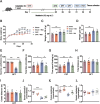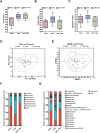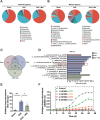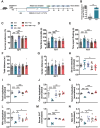Melatonin Ameliorates Depressive-Like Behaviors in Ovariectomized Mice by Improving Tryptophan Metabolism via Inhibition of Gut Microbe Alistipes Inops
- PMID: 38978348
- PMCID: PMC11425877
- DOI: 10.1002/advs.202309473
Melatonin Ameliorates Depressive-Like Behaviors in Ovariectomized Mice by Improving Tryptophan Metabolism via Inhibition of Gut Microbe Alistipes Inops
Abstract
Melatonin (N-acetyl-5-methoxytryptamine) is reported to improve mood disorders in perimenopausal women and gut microbiome composition is altered during menopausal period. The possible role of microbiome in the treatment effect of melatonin on menopausal depression remains unknown. Here, it is shown that melatonin treatment reverses the gut microbiota dysbiosis and depressive-like behaviors in ovariectomy (OVX) operated mice. This effect of melatonin is prevented by antibiotic cocktails (ABX) treatment. Transferring microbiota harvested from adolescent female mice to OVX-operated mice is sufficient to ameliorate depressive-like behaviors. Conversely, microbiota transplantation from OVX-operated mice or melatonin-treated OVX-operated mice to naïve recipient mice exhibits similar phenotypes to donors. The colonization of Alistipes Inops, which is abundant in OVX-operated mice, confers the recipient with depressive-like behaviors. Further investigation indicates that the expansion of Alistipes Inops induced by OVX leads to the degradation of intestinal tryptophan, which destroys systemic tryptophan availability. Melatonin supplementation restores systemic tryptophan metabolic disorders by suppressing the growth of Alistipes Inops, which ameliorates depressive-like behaviors. These results highlight the previously unrecognized role of Alistipes Inops in the modulation of OVX-induced behavioral disorders and suggest that the application of melatonin to inhibit Alistipes Inops may serve as a potential strategy for preventing menopausal depressive symptoms.
Keywords: gut microbiota; melatonin; menopausal depression; tryptophans.
© 2024 The Author(s). Advanced Science published by Wiley‐VCH GmbH.
Conflict of interest statement
The authors declare no conflict of interest.
Figures








References
-
- Roberts N. L., Mountjoy‐Venning W. C., Anjomshoa M., Banoub J. A., Yasin Y. J., Lancet 2018, 392, 1789.
-
- Kuehner C., The Lancet Psychiatry 2017, 4, 146. - PubMed
MeSH terms
Substances
Grants and funding
LinkOut - more resources
Full Text Sources
Medical
